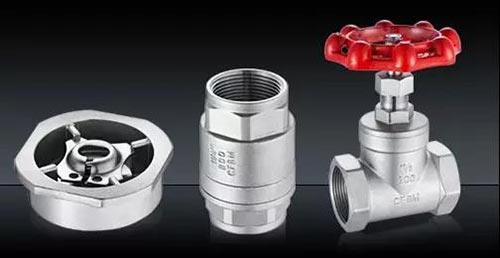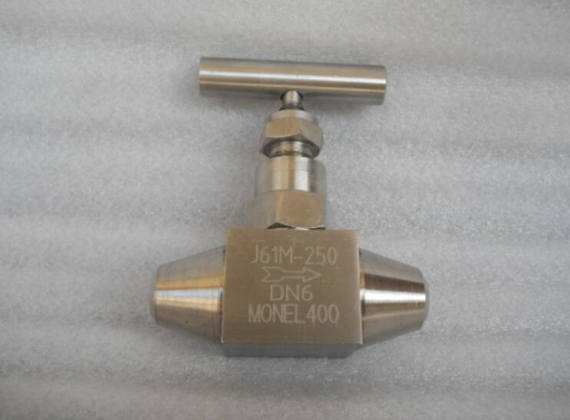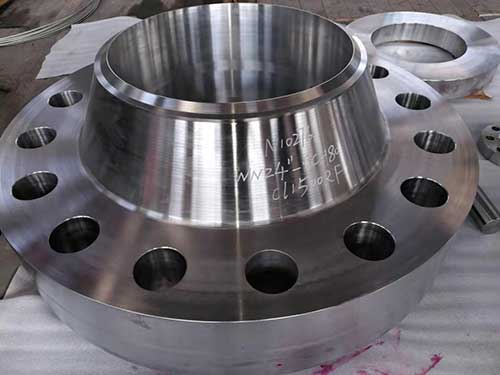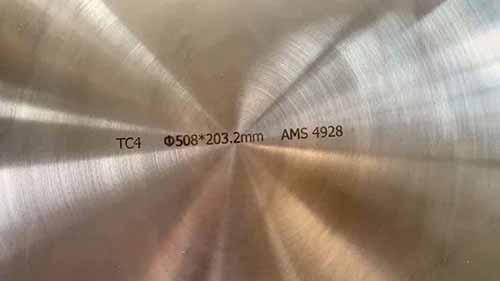Appropriate working temperature of steel and alloy for valve body parts.(HY-industry technical centre)
1 Overview
 One of the issues that must be considered in valve design and material selection is the operating temperature of the valve. In order to standardize the suitable working temperature of the valve body material, from the aspects of the material performance of various types of valve steel and alloy grades, the suitable working temperature of the valve body material used in China’s petrochemical, chemical, chemical fertilizer, power and metallurgy industries and related The requirements have made clear provisions for the design, manufacture and inspection of valve products. In addition, from the aspects of technical management, production management and material procurement, for each type of steel, the comprehensive performance should be selected, and it is not appropriate to choose too many steel grades and alloy grades to prevent confusion.
One of the issues that must be considered in valve design and material selection is the operating temperature of the valve. In order to standardize the suitable working temperature of the valve body material, from the aspects of the material performance of various types of valve steel and alloy grades, the suitable working temperature of the valve body material used in China’s petrochemical, chemical, chemical fertilizer, power and metallurgy industries and related The requirements have made clear provisions for the design, manufacture and inspection of valve products. In addition, from the aspects of technical management, production management and material procurement, for each type of steel, the comprehensive performance should be selected, and it is not appropriate to choose too many steel grades and alloy grades to prevent confusion.
2 Low temperature conditions
2.1 Ultra-low temperature valve materials
-
Ultra-low temperature valve [-254 (liquid hydrogen) ~ -101 ℃ (ethylene)] The main material must be face-centered cubic lattice austenitic stainless steel, copper alloy or aluminum alloy, its low temperature mechanical properties after heat treatment, especially low temperature impact Toughness must meet standard requirements.
-
The following austenitic stainless steels can be used to manufacture ultra-low temperature valves. ASTM A351 CF8M, CF3M, CF8 and CF3, ASTM A182 F316, F316L, F304 and F304L, ASTM A433 316, 316L, 304, 304L and CF8D (designed by Shanghai HY Industry Co., Ltd, factory standard code GFQ81-93) Before finishing, the valve body, bonnet, gate or disc of ultra-low temperature valve must be cryogenically treated in liquid nitrogen (-196 ℃).
2.2 Cryogenic valve materials
-
Main materials suitable for low-temperature valves (-100 ~ -30 ℃) are low-temperature austenitic stainless steel and ferrite and martensitic steel for low-temperature pressure parts.
-
Austenitic stainless steels for low temperature include ASTM A351 CF8M, CF3M, CF8 and CF3, ASTM A182 F316, F316L, F304 and F304L, ASTM A433 316, 316L, 304, 304L and CF8D.
-
Ferrite and martensitic steels for low temperature pressure parts include ASTM A352 LCA (-32 ℃), LCB, LCC (-46 ℃), LC1 (-59 ℃), LC2, LC211 (-73 ℃) and LC3 ( -100 ℃).
-
The primary price of materials in the ASTM A352 standard is low, but the chemical composition of its smelting must have reliable and very strict factory internal control standards. Its heat treatment process is complex, and it needs multiple times of quenching and tempering treatment to meet the low temperature impact toughness requirements of the standard, and the production cycle is long. When the low temperature impact toughness does not meet the standard requirements, it is not allowed to use the material as low temperature steel. Therefore, it is only used when the production volume is large and can be smelted into a furnace. In general, austenitic stainless steel is used.
3 Non-corrosive working conditions
When the working medium of the valve is non-corrosive substances such as water, steam, air and oil, carbon steel is generally used. Carbon steel for valves refers to WCB, WCC cast steel and ASTM A105 forged steel in the ASTM A216 standard. The suitable working temperature of carbon steel for valves is -29 ~ 425 ℃. But for safety, considering that the working temperature of the medium may fluctuate, therefore, the general temperature of carbon steel should not exceed 400 ℃.
4 corrosion conditions
4.1 Chrome-molybdenum high temperature steel
-
The Cr-Mo high-temperature cast steel used for the valve mainly adopts WC6, WC9 and C5 (ZG1Cr5Mo) in the ASTM A217 standard, and the corresponding rolled materials are F11, F22 and F5 in ASTM A182 respectively.
-
Low chromium grade chromium-molybdenum steel: Low chromium grade chromium-molybdenum steel has WC6, WC9, F11 and F22, the applicable working medium is water, steam and hydrogen, not suitable for sulfur-containing oil products. The suitable working temperature of WC6 and F11 is -29 ~ 540 ℃, and the suitable working temperature of WC9 and F22 is -29 ~ 570 ℃.
-
Chromium five molybdenum high temperature steel: chromium five molybdenum high temperature steel has C5 (ZG1Cr5Mo) and F5, the applicable working medium is water, steam, hydrogen and sulfur-containing oil products.
-
If C5 (ZG1Cr5Mo) is used for steam, the maximum working temperature is 600 ℃. When used in working media such as sulfur-containing oils, the maximum working temperature is 550 ℃. Therefore, the working temperature of C5 (ZG1Cr5Mo) is ≤550 ℃.
4.2 Stainless acid-resistant steel
-
Stainless acid-resistant steel refers to chromium-nickel or chromium-nickel-molybdenum stainless acid-resistant steel used in petrochemical, chemical, and fertilizer industries to resist nitric acid, sulfuric acid, acetic acid, and organic acids. Stainless acid-resistant steel cast steel mainly adopts CF8, CF8M, CF3, CF3M, CF8C, CD-4MCu and CN7M in ASTM A743 or ASTM A744 standards, and their corresponding rolling materials are F304, F316, F304L in ASTM A182 standard, respectively , F316L, F347, F53 and United States UNS N08020.
-
Cr-Ni stainless steel: Cr-Ni stainless acid-resistant steels are CF8, CF3, F304, F304L, CF8C and F347, which are suitable for oxidizing acids such as nitric acid. Its maximum working temperature is ≤200 ℃.
-
Cr-Ni-Mo stainless steel: Cr-Ni-Mo stainless acid-resistant steels are CF8M, CF3M, F316 and F316L, which are suitable for working media such as acetic acid and other reducing acids.
-
CF8M, CF3M, etc. can replace CF8 and CF3, but CF8, CF3 cannot replace CF8M and CF3M. Therefore, CF8M and CF3M are mainly used for stainless acid-resistant steel valves in the United States and other countries, and their maximum working temperature is ≤200 ℃.
-
CN7M alloy: CN7M alloy has good overall corrosion resistance, it is widely used in harsh corrosion conditions, including sulfuric acid, nitric acid, hydrofluoric acid and dilute hydrochloric acid, caustic alkali, sea water and hot chloride salt solution, etc. Especially it can be used in sulfuric acid with various concentration and temperature≤70 ℃. The service temperature of CN7M and UNS N08020 alloy is -29 ~ 450 ℃.
-
Duplex stainless steel: Duplex stainless corrosion-resistant steels (Table 1) are precipitation hardening stainless steels. They are 35% to 40% austenite in the ferrite matrix and their yield strength is about 19Cr-9Ni austenitic It is twice as bulk stainless steel, and has high hardness and good plasticity and impact toughness. It is especially suitable for use under corrosive working conditions with both abrasion and erosion, so it is widely used in strong acid conditions of oxidation and reduction, and has special resistance to stress corrosion cracking in the environment with chlorine. The service temperature of CD-4MCu, CD3MN, CE3MN and F53 duplex stainless steel is -29 ~ 316 ℃.
4.3 Corrosion-resistant nickel-based alloy
Corrosion-resistant nickel-based alloy valves mainly use cast Monel (M35-1), cast nickel alloy (CZ-100), Inconel (CY-40), Hastelloy B (N-12MV) in ASTM A494 , N-7M) and Hastelloy C (CW-12MW, CW-7M, CW-6MC, CW-2M).
The Monel alloy rolled materials used for corrosion-resistant Monel alloy valves are mainly UNS N04400 (Monel 400) and UNS N05500 (Monel K500). There is no corresponding rolled material for cast nickel alloys. Inconel 600 and Inconel 625 are the rolled materials for Inconel.
-
 Monel alloy: Monel alloy has high strength and toughness, especially has excellent resistance to reducing acid and strong alkali medium and seawater corrosion. Therefore, it is usually used to manufacture equipment and valves that transport hydrofluoric acid, brine, neutral media, alkali salts and reducing acids. It is also suitable for drying chlorine gas, hydrogen chloride, high temperature chlorine gas at 425 ℃, and hydrogen chloride gas at 450 ℃ Medium, but not resistant to corrosion by sulfur-containing media and oxidizing media (such as nitric acid and media with high oxygen content). The valve material code of the Monel alloy is MM, the valve material of the inner part is Monel alloy, the valve material code is C / M when the shell is carbon steel, and the valve material code is P / M and the shell is CF8. When the body is CF8M, the valve material code is R / M. The suitable working temperature of Monel alloy M35-1, Monel 400 and Monel K500 alloy is -29 ~ 480 ℃.
Monel alloy: Monel alloy has high strength and toughness, especially has excellent resistance to reducing acid and strong alkali medium and seawater corrosion. Therefore, it is usually used to manufacture equipment and valves that transport hydrofluoric acid, brine, neutral media, alkali salts and reducing acids. It is also suitable for drying chlorine gas, hydrogen chloride, high temperature chlorine gas at 425 ℃, and hydrogen chloride gas at 450 ℃ Medium, but not resistant to corrosion by sulfur-containing media and oxidizing media (such as nitric acid and media with high oxygen content). The valve material code of the Monel alloy is MM, the valve material of the inner part is Monel alloy, the valve material code is C / M when the shell is carbon steel, and the valve material code is P / M and the shell is CF8. When the body is CF8M, the valve material code is R / M. The suitable working temperature of Monel alloy M35-1, Monel 400 and Monel K500 alloy is -29 ~ 480 ℃. -
Cast nickel alloy: The chemical composition of cast nickel alloy (CZ-100) is 95% Ni and 1.00% C, which has no corresponding rolled material. When CZ-100 is used in high temperature and high concentration or anhydrous alkali solution, it has excellent corrosion resistance. CZ-100 is commonly used in the production of chlor-alkali with high corrosive concentration (including molten anhydrous caustic soda) and where there are no metal-contaminated products such as copper and iron. The material code of the cast nickel alloy CZ-100 valve is Ni. The suitable working temperature of CZ-100 alloy is -29 ~ 316 ℃.
-
Inconel: Inconel CY-40 and Inconel 600 (ASTM B564 N06600), etc. are mainly used for stress corrosion resistance, especially suitable for high concentration chloride media. When the Ni content ≥45%, the The stress corrosion has an “immune” effect. In addition, it can also resist the corrosion of boiling concentrated nitric acid, fuming nitric acid, high-temperature gases and combustion products containing sulfur and vanadium. Inconel alloy has been widely used in the manufacture of components for boiler feed water systems in nuclear power plants because it is more secure than stainless steel. At the same time, it is also suitable for industrial production that requires high-strength, high-pressure sealing, high corrosion resistance, and resistance to mechanical wear and oxidation at high temperatures. For example, large-scale fertilizer plants use Inconel 600 or Inconel 625 alloy (the rolling material grade of Hastelloy CW-6MC) to manufacture high-pressure (600-1500LB) high-concentration oxygen valves. The material code of CY-40 and Inconel 600 alloy valve is In. The suitable working temperature is -29 ~ 650 ℃.
-
Hastelloy: Hastelloy is a commercial brand name, which includes a series of alloy grades, mainly used in corrosion-resistant valves are Hastelloy B and Hastelloy C.
-
Hastelloy B‘s cast alloy grades are N-12MV (N-12M-1) and N-7M (some data is called N-12M-2, also known as Chlorimet2 alloy) in ASTM A494 standard, and its rolled material The grade is UNS N10665 in the ASTM B335 standard. Hastelloy B is resistant to various concentrations of hydrochloric acid, as well as non-oxidizing salts and acids. Hastelloy B’s corrosion-resistant valve should be low-carbon Hastelloy B (N-7M) for corrosion resistance and intergranular corrosion resistance.
-
The material code of Hastelloy has no regulations in the valve industry. The material code of Hastelloy B valve can be directly expressed by its cast alloy grade. Hastelloy B’s suitable working temperature is -29 ℃ ~ 425 ℃. Hastelloy C’s casting alloy grades are CW-12MW (some materials call it CW-12M-1) and CW-7M (CW-12M-2, also known as Chlorimet3 alloy) and Hastelloy C-276 alloy, its casting The alloy grade is CW-6MC, Hastelloy C-4 alloy, and the casting alloy grade is CW-2M. Casting Hastelloy CW-7M, CW-12MW, CW-6MC and CW-2M, the corresponding rolling material grades are UNS N10001, UNS N10003, UNS N10276 and UNS N06455 Hastelloy C is resistant to oxidizing solvents, low concentrations of room temperature hydrochloric acid and nitric acid.
-
The first generation Hastelloy C (0Cr16Ni60Mo16W4) is characterized by strong corrosion resistance in the oxidizing and reducing acid medium, but it has excellent corrosion resistance, but because the high-nickel corrosion-resistant alloy is austenitic, because Ni reduces Reasons such as solid solubility in austenite. Therefore, both the Ni-Mo Hastelloy B and Ni-Mo-Cr Hastelloy C alloys have a severe tendency or sensitivity to intergranular corrosion, which can also cause stress corrosion and crevice corrosion at high temperatures.
-
 In order to overcome intergranular corrosion, the second-generation Hastelloy C-276 (C reduced from 0.03% to 0.02%) and the third-generation Hastelloy C-4 were introduced, which were characterized by low Si (Si≤0.08%) and ultramicro C (C≤0.015%), and reduce the content of Fe and W, adding the stabilized alloy element Ti and so on. The Hastelloy C corrosion-resistant valve should be selected from Hastelloy C-276 (CW-6MC) and Hastelloy C-4 (CW-2M) in terms of corrosion resistance and intergranular corrosion resistance. There are many material codes for Hastelloy C valves, and the performance and operating temperature differ greatly, so CW-12MW, CW-7M, CW-6MC and CW-2M are represented by HC-12, HC-7, HC-276 and HC-4, respectively , Or directly expressed by its cast alloy grade.
In order to overcome intergranular corrosion, the second-generation Hastelloy C-276 (C reduced from 0.03% to 0.02%) and the third-generation Hastelloy C-4 were introduced, which were characterized by low Si (Si≤0.08%) and ultramicro C (C≤0.015%), and reduce the content of Fe and W, adding the stabilized alloy element Ti and so on. The Hastelloy C corrosion-resistant valve should be selected from Hastelloy C-276 (CW-6MC) and Hastelloy C-4 (CW-2M) in terms of corrosion resistance and intergranular corrosion resistance. There are many material codes for Hastelloy C valves, and the performance and operating temperature differ greatly, so CW-12MW, CW-7M, CW-6MC and CW-2M are represented by HC-12, HC-7, HC-276 and HC-4, respectively , Or directly expressed by its cast alloy grade. -
The suitable working temperature of Hastelloy CW-7M and UNS N10001 alloy is -29 ~ 425 ℃, the suitable working temperature of HastelloyCW-12MW and UNS N10003 alloy is -29 ~ 700 ℃, the suitable working temperature of HastelloyCW-6MC and UNS N10276 alloy is- 29 ~ 676 ℃, the suitable working temperature of HastelloyCW-2M and UNS N06455 alloy is -29 ~ 425 ℃.
4.4 Titanium alloy
-
 Titanium (Ti) has high strength, light weight, high enough heat resistance and low temperature toughness, and good processability and welding performance. It is mainly used in valve production for casting pure titanium and forging pure titanium ZTA2.
Titanium (Ti) has high strength, light weight, high enough heat resistance and low temperature toughness, and good processability and welding performance. It is mainly used in valve production for casting pure titanium and forging pure titanium ZTA2. -
Titanium exhibits corrosion resistance, non-corrosion resistance, even fire, explosion, etc. due to temperature and other working conditions. Therefore, when ordering and design selection, the nature (concentration, temperature, etc.) of the medium used should be clearly defined.
-
Titanium valves have excellent corrosion resistance in a variety of oxidizing and highly corrosive media and neutral media.
-
Titanium has excellent corrosion resistance in nitric acid below the boiling point and concentration ≤80%. In fuming nitric acid, when the NO2 content exceeds 2% and the water content is insufficient, the reaction between titanium and fuming nitric acid will explode. Therefore, titanium is generally not used for high temperature nitric acid with a content of more than 80%.
-
Titanium is not corrosion resistant in sulfuric acid, and titanium has moderate corrosion resistance in hydrochloric acid. It is generally believed that industrial pure titanium can be used in hydrochloric acid with a concentration of 7.5% at room temperature, 3% at 60 ° C and 0.5% at 100 ° C. Titanium can also be used for 30% at 35 ° C, 10% and 100 at 60 ° C In phosphoric acid with a concentration of 3% at ℃.
-
Titanium is not resistant to HF (hydrofluoric acid), titanium is not resistant to acid fluoride solutions, titanium is resistant to boric acid and chromic acid, and can be used in hydroiodic acid and hydrobromic acid.
-
Titanium can be used in mixed acid of 60% 10% sulfuric acid and 90% nitric acid, boiling mixed acid of 1% hydrochloric acid and 5% nitric acid and room temperature aqua regia (Note: aqua regia is a mixture of 3 volumes concentrated hydrochloric acid and 1 volume concentrated nitric acid) in.
-
Titanium is completely corrosion-resistant in various concentrations of barium hydroxide, calcium hydroxide, magnesium hydroxide, sodium hydroxide and potassium hydroxide solutions at room temperature, but it cannot be used in boiling sodium hydroxide and potassium hydroxide. The ammonia in the alkali will aggravate the corrosion of titanium.
-
The maximum working temperature of titanium in tap water, river water and air is 300 ℃. Titanium can be used in seawater with a maximum flow rate of 20m / s. Titanium has high corrosion resistance in seawater with a temperature ≤120 ℃. If the temperature is higher than 120 ℃, pitting corrosion and crevice corrosion may occur.
-
Titanium has excellent corrosion resistance to all organic acids except formic acid, oxalic acid and concentrated citric acid (concentration ≥50%), but when the water content in the organic acid is too low (<0.1%), titanium is easy Pitting corrosion occurred.
-
Titanium has excellent corrosion resistance in hydrocarbons and chlorinated hydrocarbons. Titanium can react violently in dry chlorine gas to form TiCl4, and there is a danger of fire, but titanium has good corrosion resistance in wet chlorine (water content of 0.3 to 1.5%).
-
Titanium is stable in HCl dried at 20-160 ° C, but hydrochloric acid causes corrosion of titanium in wet hydrogen chloride.
-
The pitting potential of titanium in chloride solutions is higher than that of stainless steel, and the pitting resistance of titanium against chloride ions is better than that of stainless steel. Therefore, titanium has been widely used in chloride solutions.
-
Titanium generally does not produce pitting corrosion when the temperature is ≤80 ° C, but at high temperature, the medium concentration chloride solution (such as 25% aluminum chloride solution at 100 ° C, 70% calcium chloride solution at 175 ° C, 25% at 200 ° C) % Magnesium chloride solution and 200% 75% zinc chloride solution) pitting corrosion is more likely to occur.
5 High temperature conditions:High-temperature operating valves mainly refer to high-temperature valves used in oil refineries
-
Sub-high temperature: Sub-high temperature means the working temperature of the valve is in the range of 325 ~ 425 ℃. If the medium is water and steam, WCB, WCC, A105, WC6 and WC9 are mainly used. If the medium is sulfur-containing oil, C5, CF8, CF3, CF8M, CF3M, etc., which are resistant to sulfide corrosion, are mainly used. They are mostly used in atmospheric and vacuum devices and delayed coking devices in oil refineries. At this time, valves made of CF8, CF8M, CF3 and CF3M are not used for acid solution corrosion, but for sulfur-containing oil products and oil and gas pipelines. In this working condition, the maximum working temperature of CF8, CF8M, CF3 and CF3M is 450 ℃.
-
High temperature class I: the working temperature of the valve is 425 ~ 550 ℃ is high temperature class I (referred to as PI class). The main body material of the PI-grade valve is CF8 in the ASTM A351 standard, “high-temperature grade I medium-carbon chromium-nickel rare earth titanium high-quality heat-resistant steel.” Because PI grade is a specific name, the concept of high temperature stainless steel (P) is included here. Therefore, if the working medium is water or steam, although high-temperature steel WC6 (t ≤ 540 ℃) or WC9 (t ≤ 570 ℃) can also be used, although high-temperature steel C5 (ZG1Cr5Mo) can also be used for sulfur-containing oil They cannot be called PI grades here.
-
High temperature class II: The working temperature of the valve is 550 ~ 650 ℃, which is set as high temperature class II (referred to as P class II for short). PⅡ high temperature valve is mainly used in heavy oil catalytic cracking device of oil refinery. It contains high temperature lining wear-resistant gate valve used in three-rotating nozzle and other parts. The main material of the PII valve is CF8 in the ASTM A351 standard, “high temperature II grade medium carbon chromium nickel rare earth titanium tantalum reinforced heat resistant steel”.
-
High temperature class III: The working temperature of the valve is 650 ~ 730 ℃, set as high temperature class III (referred to as PⅢ class). PⅢ high temperature valves are mainly used in large heavy oil catalytic cracking units in refineries. The main body material of PⅢ high temperature valve is CF8M based on ASTM A351 standard “High temperature III grade medium carbon chromium nickel molybdenum rare earth titanium tantalum reinforced heat resistant steel”.
-
High temperature class IV: The working temperature of the valve is 730 ~ 816 ℃, set as high temperature class IV (referred to as PⅣ class). The upper limit of the operating temperature of the PIV valve is 816 ° C because the maximum temperature provided in the standard ASME B16.34 pressure-temperature rating of the valve design is 816 ° C (1500 ° F). In addition, after the working temperature exceeds 816 ° C, the steel is close to entering the forging temperature zone. At this time, the metal is in the plastic deformation zone, and the metal has good plasticity. The main material of the PⅣ valve is CF8M in the ASTM A351 standard, which is a basic type “high temperature IV grade medium carbon chromium nickel molybdenum rare earth titanium tantalum reinforced heat resistant steel”. Heat-resistant stainless steels such as F310 (including C content ≥0.050%) and F310H in CK-20 and ASTM A182 standards.
-
High temperature Ⅴ level: The working temperature of the valve is above 816 ℃, which is called high temperature Ⅴ level (referred to as P Ⅴ level for short). PⅤ high-temperature valves (valves used for shut-off, not valves of adjustable butterfly valves) must use special design methods, such as thermal insulation lining or water or air cooling to ensure the normal operation of the valve. Therefore, the upper limit of the working temperature of the PⅤ high-temperature valve is not specified, because the working temperature of the control valve is not solved only by materials, but by special design means, and the basic principles of the design means are the same. PⅤ high temperature valve can choose reasonable materials that can meet the valve according to its working medium and working pressure and the special design method adopted. In the PⅤ high temperature valve, usually the flue insert valve or butterfly valve insert or butterfly plate often chooses HK-30 and HK-40 high temperature alloy in ASTM A297 standard, they can resist oxidation and reducing gas below 1150 Medium corrosion resistance, but can not bear impact and high pressure load.


